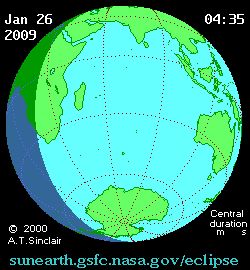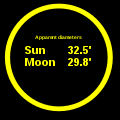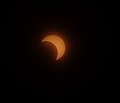| Solar eclipse of January 26, 2009 | |
|---|---|
 Annularity from Palangka Raya, Indonesia | |
| Type of eclipse | |
| Nature | Annular |
| Gamma | −0.282 |
| Magnitude | 0.9282 |
| Maximum eclipse | |
| Duration | 474 s (7 min 54 s) |
| Coordinates | 34°06′S 70°12′E / 34.1°S 70.2°E / -34.1; 70.2 |
| Max. width of band | 280 km (170 mi) |
| Times (UTC) | |
| Greatest eclipse | 7:59:45 |
| References | |
| Saros | 131 (50 of 70) |
| Catalog # (SE5000) | 9527 |
An annular solar eclipse occurred at the Moon's ascending node of orbit on Monday, January 26, 2009, with a magnitude of 0.9282. A solar eclipse occurs when the Moon passes between Earth and the Sun, thereby totally or partly obscuring the image of the Sun for a viewer on Earth. An annular solar eclipse occurs when the Moon's apparent diameter is smaller than the Sun's, blocking most of the Sun's light and causing the Sun to look like an annulus (ring). An annular eclipse appears as a partial eclipse over a region of the Earth thousands of kilometres wide. Occurring about 3.3 days after apogee (on January 23, 2009, at 0:10 UTC), the Moon's apparent diameter was smaller.
The eclipse was visible from a narrow corridor beginning in the south Atlantic Ocean and sweeping eastward 900 km south of Africa, slowly curving northeast through the Indian Ocean. Its first landfall was in the Cocos Islands followed by southern Sumatra and western Java. It continued somewhat more easterly across central Borneo, across the northwestern edge of Celebes, then ending just before Mindanao, Philippines. The duration of annularity at greatest eclipse lasted 7 minutes, 53.58 seconds, but at greatest duration lasted 7 minutes, 56.05 seconds. A partial eclipse was visible for parts of Southern Africa, East Antarctica, Southeast Asia, the Philippines, and Australia.
Visibility
Images

Progression from Colombo, Sri Lanka
-
Simulated view of relative diameters of Sun and Moon, as viewed near sunset at the central eclipse path over Borneo.
-
George, South Africa, 6:04 UTC
-
Bloemfontein, South Africa, 6:18 UTC
-
Riversdale, South Africa. 6:21 UTC
-
Cape Town, South Africa, 6:30 UTC
-
Helpmekaar Kollege, South Africa, 6:54 UTC
-
Bukit Merah, Singapore, 9:27 UTC
-
Chennai, India, 9:29 UTC
-
Jakarta, Indonesia, 9:41 UTC
-
Rajshahi, Bangladesh, 9:43 UTC
-
Bandung, Indonesia, 9:48 UTC
-
Subang Jaya, Malaysia, 9:51 UTC
-
Nugegoda, Sri Lanka, 9:58 UTC
-
Bangalore, India, 10:02 UTC
-
Serang, Indonesia, 10:22 UTC
Eclipse details
Shown below are two tables displaying details about this particular solar eclipse. The first table outlines times at which the moon's penumbra or umbra attains the specific parameter, and the second table describes various other parameters pertaining to this eclipse.
| Event | Time (UTC) |
|---|---|
| First Penumbral External Contact | 2009 January 26 at 04:57:42.7 UTC |
| First Umbral External Contact | 2009 January 26 at 06:03:44.5 UTC |
| First Central Line | 2009 January 26 at 06:06:54.1 UTC |
| First Umbral Internal Contact | 2009 January 26 at 06:10:04.0 UTC |
| First Penumbral Internal Contact | 2009 January 26 at 07:22:11.5 UTC |
| Greatest Duration | 2009 January 26 at 07:43:23.8 UTC |
| Equatorial Conjunction | 2009 January 26 at 07:47:30.2 UTC |
| Ecliptic Conjunction | 2009 January 26 at 07:56:23.1 UTC |
| Greatest Eclipse | 2009 January 26 at 07:59:44.5 UTC |
| Last Penumbral Internal Contact | 2009 January 26 at 08:37:36.7 UTC |
| Last Umbral Internal Contact | 2009 January 26 at 09:49:34.5 UTC |
| Last Central Line | 2009 January 26 at 09:52:42.3 UTC |
| Last Umbral External Contact | 2009 January 26 at 09:55:49.6 UTC |
| Last Penumbral External Contact | 2009 January 26 at 11:01:46.9 UTC |
| Parameter | Value |
|---|---|
| Eclipse Magnitude | 0.92825 |
| Eclipse Obscuration | 0.86165 |
| Gamma | −0.28197 |
| Sun Right Ascension | 20h35m32.8s |
| Sun Declination | -18°38'55.0" |
| Sun Semi-Diameter | 16'14.6" |
| Sun Equatorial Horizontal Parallax | 08.9" |
| Moon Right Ascension | 20h35m55.2s |
| Moon Declination | -18°53'18.2" |
| Moon Semi-Diameter | 14'51.6" |
| Moon Equatorial Horizontal Parallax | 0°54'32.2" |
| ΔT | 65.8 s |
Eclipse season
This eclipse is part of an eclipse season, a period, roughly every six months, when eclipses occur. Only two (or occasionally three) eclipse seasons occur each year, and each season lasts about 35 days and repeats just short of six months (173 days) later; thus two full eclipse seasons always occur each year. Either two or three eclipses happen each eclipse season. In the sequence below, each eclipse is separated by a fortnight.
| January 26 Ascending node (new moon) |
February 9 Descending node (full moon) |
|---|---|
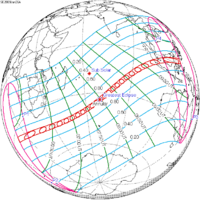 |

|
| Annular solar eclipse Solar Saros 131 |
Penumbral lunar eclipse Lunar Saros 143 |
Related eclipses
Eclipses in 2009
- An annular solar eclipse on January 26.
- A penumbral lunar eclipse on February 9.
- A penumbral lunar eclipse on July 7.
- A total solar eclipse on July 22.
- A penumbral lunar eclipse on August 6.
- A partial lunar eclipse on December 31.
Metonic
- Preceded by: Solar eclipse of April 8, 2005
- Followed by: Solar eclipse of November 13, 2012
Tzolkinex
- Preceded by: Solar eclipse of December 14, 2001
- Followed by: Solar eclipse of March 9, 2016
Half-Saros
- Preceded by: Lunar eclipse of January 21, 2000
- Followed by: Lunar eclipse of January 31, 2018
Tritos
- Preceded by: Solar eclipse of February 26, 1998
- Followed by: Solar eclipse of December 26, 2019
Solar Saros 131
- Preceded by: Solar eclipse of January 15, 1991
- Followed by: Solar eclipse of February 6, 2027
Inex
- Preceded by: Solar eclipse of February 16, 1980
- Followed by: Solar eclipse of January 5, 2038
Triad
- Preceded by: Solar eclipse of March 28, 1922
- Followed by: Solar eclipse of November 27, 2095
Solar eclipses of 2008–2011
This eclipse is a member of a semester series. An eclipse in a semester series of solar eclipses repeats approximately every 177 days and 4 hours (a semester) at alternating nodes of the Moon's orbit.
The partial solar eclipses on June 1, 2011 and November 25, 2011 occur in the next lunar year eclipse set.
| Solar eclipse series sets from 2008 to 2011 | ||||||
|---|---|---|---|---|---|---|
| Ascending node | Descending node | |||||
| Saros | Map | Gamma | Saros | Map | Gamma | |
121 Partial in Christchurch, New Zealand |
February 7, 2008 Annular |
−0.95701 | 126 Totality in Kumul, Xinjiang, China |
August 1, 2008 Total |
0.83070 | |
131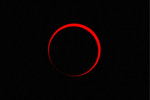 Annularity in Palangka Raya, Indonesia |
January 26, 2009 Annular |
−0.28197 | 136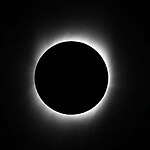 Totality in Kurigram District, Bangladesh |
July 22, 2009 Total |
0.06977 | |
141 Annularity in Jinan, Shandong, China |
January 15, 2010 Annular |
0.40016 | 146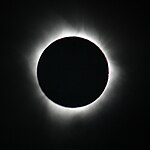 Totality in Hao, French Polynesia |
July 11, 2010 Total |
−0.67877 | |
151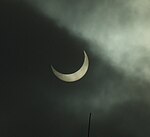 Partial in Poland |
January 4, 2011 Partial |
1.06265 | 156 | July 1, 2001 Partial |
−1.49171 | |
Saros 131
This eclipse is a part of Saros series 131, repeating every 18 years, 11 days, and containing 70 events. The series started with a partial solar eclipse on August 1, 1125. It contains total eclipses from March 27, 1522 through May 30, 1612; hybrid eclipses from June 10, 1630 through July 24, 1702; and annular eclipses from August 4, 1720 through June 18, 2243. The series ends at member 70 as a partial eclipse on September 2, 2369. Its eclipses are tabulated in three columns; every third eclipse in the same column is one exeligmos apart, so they all cast shadows over approximately the same parts of the Earth.
The longest duration of totality was produced by member 28 at 58 seconds on May 30, 1612, and the longest duration of annularity was produced by member 50 at 7 minutes, 54 seconds on January 26, 2009. All eclipses in this series occur at the Moon’s ascending node of orbit.
| Series members 39–60 occur between 1801 and 2200: | ||
|---|---|---|
| 39 | 40 | 41 |
 September 28, 1810 |
 October 9, 1828 |
 October 20, 1846 |
| 42 | 43 | 44 |
 October 30, 1864 |
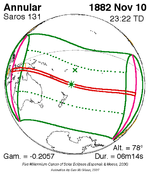 November 10, 1882 |
 November 22, 1900 |
| 45 | 46 | 47 |
 December 3, 1918 |
 December 13, 1936 |
 December 25, 1954 |
| 48 | 49 | 50 |
 January 4, 1973 |
 January 15, 1991 |
 January 26, 2009 |
| 51 | 52 | 53 |
 February 6, 2027 |
 February 16, 2045 |
 February 28, 2063 |
| 54 | 55 | 56 |
 March 10, 2081 |
 March 21, 2099 |
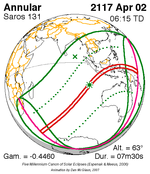 April 2, 2117 |
| 57 | 58 | 59 |
 April 13, 2135 |
 April 23, 2153 |
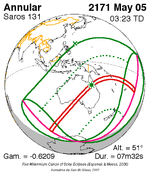 May 5, 2171 |
| 60 | ||
 May 15, 2189 | ||
Metonic series
The metonic series repeats eclipses every 19 years (6939.69 days), lasting about 5 cycles. Eclipses occur in nearly the same calendar date. In addition, the octon subseries repeats 1/5 of that or every 3.8 years (1387.94 days). All eclipses in this table occur at the Moon's ascending node.
| 21 eclipse events between June 21, 1982 and June 21, 2058 | ||||
|---|---|---|---|---|
| June 21 | April 8–9 | January 26 | November 13–14 | September 1–2 |
| 117 | 119 | 121 | 123 | 125 |
 June 21, 1982 |
 April 9, 1986 |
 January 26, 1990 |
 November 13, 1993 |
 September 2, 1997 |
| 127 | 129 | 131 | 133 | 135 |
 June 21, 2001 |
 April 8, 2005 |
 January 26, 2009 |
 November 13, 2012 |
 September 1, 2016 |
| 137 | 139 | 141 | 143 | 145 |
 June 21, 2020 |
 April 8, 2024 |
 January 26, 2028 |
 November 14, 2031 |
 September 2, 2035 |
| 147 | 149 | 151 | 153 | 155 |
 June 21, 2039 |
 April 9, 2043 |
 January 26, 2047 |
 November 14, 2050 |
 September 2, 2054 |
| 157 | ||||
 June 21, 2058 | ||||
Tritos series
This eclipse is a part of a tritos cycle, repeating at alternating nodes every 135 synodic months (≈ 3986.63 days, or 11 years minus 1 month). Their appearance and longitude are irregular due to a lack of synchronization with the anomalistic month (period of perigee), but groupings of 3 tritos cycles (≈ 33 years minus 3 months) come close (≈ 434.044 anomalistic months), so eclipses are similar in these groupings.
| Series members between 1801 and 2200 | ||||
|---|---|---|---|---|
 September 8, 1801 (Saros 112) |
 August 7, 1812 (Saros 113) |
 July 8, 1823 (Saros 114) |
 June 7, 1834 (Saros 115) |
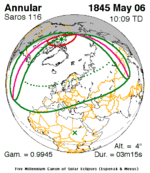 May 6, 1845 (Saros 116) |
 April 5, 1856 (Saros 117) |
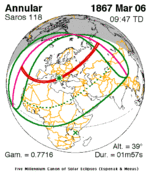 March 6, 1867 (Saros 118) |
 February 2, 1878 (Saros 119) |
 January 1, 1889 (Saros 120) |
 December 3, 1899 (Saros 121) |
 November 2, 1910 (Saros 122) |
 October 1, 1921 (Saros 123) |
 August 31, 1932 (Saros 124) |
 August 1, 1943 (Saros 125) |
 June 30, 1954 (Saros 126) |
 May 30, 1965 (Saros 127) |
 April 29, 1976 (Saros 128) |
 March 29, 1987 (Saros 129) |
 February 26, 1998 (Saros 130) |
 January 26, 2009 (Saros 131) |
 December 26, 2019 (Saros 132) |
 November 25, 2030 (Saros 133) |
 October 25, 2041 (Saros 134) |
 September 22, 2052 (Saros 135) |
 August 24, 2063 (Saros 136) |
 July 24, 2074 (Saros 137) |
 June 22, 2085 (Saros 138) |
 May 22, 2096 (Saros 139) |
 April 23, 2107 (Saros 140) |
 March 22, 2118 (Saros 141) |
 February 18, 2129 (Saros 142) |
 January 20, 2140 (Saros 143) |
 December 19, 2150 (Saros 144) |
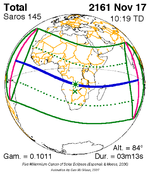 November 17, 2161 (Saros 145) |
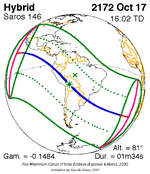 October 17, 2172 (Saros 146) |
 September 16, 2183 (Saros 147) |
 August 16, 2194 (Saros 148) | |||
Inex series
This eclipse is a part of the long period inex cycle, repeating at alternating nodes, every 358 synodic months (≈ 10,571.95 days, or 29 years minus 20 days). Their appearance and longitude are irregular due to a lack of synchronization with the anomalistic month (period of perigee). However, groupings of 3 inex cycles (≈ 87 years minus 2 months) comes close (≈ 1,151.02 anomalistic months), so eclipses are similar in these groupings.
| Series members between 1801 and 2200 | ||
|---|---|---|
 June 16, 1806 (Saros 124) |
 May 27, 1835 (Saros 125) |
 May 6, 1864 (Saros 126) |
 April 16, 1893 (Saros 127) |
 March 28, 1922 (Saros 128) |
 March 7, 1951 (Saros 129) |
 February 16, 1980 (Saros 130) |
 January 26, 2009 (Saros 131) |
 January 5, 2038 (Saros 132) |
 December 17, 2066 (Saros 133) |
 November 27, 2095 (Saros 134) |
 November 6, 2124 (Saros 135) |
 October 17, 2153 (Saros 136) |
 September 27, 2182 (Saros 137) |
|
Notes
- "January 26, 2009 Annular Solar Eclipse". timeanddate. Retrieved August 11, 2024.
- "Indonesians witness solar eclipse today". The Herald. January 26, 2009. p. 19. Retrieved October 25, 2023 – via Newspapers.com.
- "Indonesians among the few to witness solar eclipse". Whitehorse Daily Star. January 26, 2009. p. 16. Retrieved October 25, 2023 – via Newspapers.com.
- "Moon Distances for London, United Kingdom, England". timeanddate. Retrieved August 11, 2024.
- "Annular Solar Eclipse of 2009 Jan 26". EclipseWise.com. Retrieved August 11, 2024.
- van Gent, R.H. "Solar- and Lunar-Eclipse Predictions from Antiquity to the Present". A Catalogue of Eclipse Cycles. Utrecht University. Retrieved October 6, 2018.
- "NASA - Catalog of Solar Eclipses of Saros 131". eclipse.gsfc.nasa.gov.
References
- Annular Solar Eclipse of 2009 Jan 26, F. Espenak, NASA’s GSFC PDF
- Earth visibility chart and eclipse statistics Eclipse Predictions by Fred Espenak, NASA/GSFC
Photos:
- Spaceweather.com eclipse gallery
- Photos of solar eclipse around the world
- Annular solar eclipse in Indonesia
- Astronomy Picture of the Day, January 28, 2009, A Partial Eclipse Over Manila Bay, Philippines

